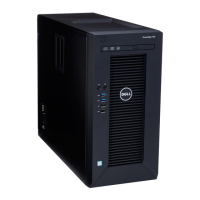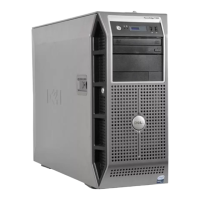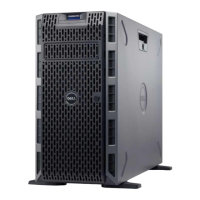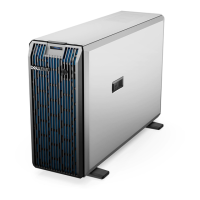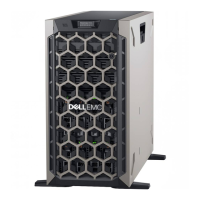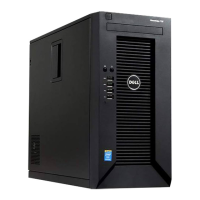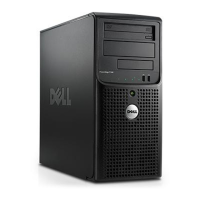




Do you have a question about the Dell PowerEdge T310 and is the answer not in the manual?
Describes keystrokes for accessing system features during startup.
Explains the Home screen display during normal system operation.
Configures network mode (DHCP/Static IP) and DNS settings.
Selects format for LCD error messages for matching SEL entries.
Selects default information displayed on the LCD Home screen.
Displays IPv4 or IPv6 addresses for iDRAC6.
Displays MAC addresses for DRAC, iSCSIn, or NETn.
Displays the Host, Model, or User String for the system.
Displays the Asset tag or Service tag for the system.
Displays system power output in BTU/hr or Watts.
Displays system temperature in Celsius or Fahrenheit.
Explains how to view system error or status messages on the LCD.
Details methods to clear LCD status messages from the display.
Specifies the boot mode (BIOS or UEFI) for operating system installation.
Instructions on how to enter the System Setup program.
Guidance on handling error messages during system boot.
Explains the keys used for navigating the System Setup program.
Sets the system's internal clock.
Sets the system's internal calendar.
Displays information related to installed memory.
Displays information related to processors.
Enables or disables integrated SATA controller and ports.
Specifies boot mode (BIOS/UEFI) and boot devices.
Enables/disables integrated devices and ports.
Changes IRQ assignments for devices.
Enables/disables serial ports and specifies features.
Configures front-panel LCD options and strings.
Manages power usage of processor, fans, memory.
Configures system and setup password features.
Sets NumLock mode activation on startup.
Enables/disables reporting of keyboard errors during POST.
Halts system on errors during POST for user observation.
Specifies if the processor supports 64-bit extensions.
Displays the processor clock speed.
Displays the processor bus speed.
Reports logical processors on processors supporting SMT.
Permits virtualization software to use processor tech.
Enables/disables execute disable memory protection.
Sets the maximum number of cores enabled.
Allows processor(s) to operate in available power states.
Enables or disables Turbo Mode if supported by processor.
Displays processor family, model, stepping.
Enables or disables the integrated SATA controller.
Enables BIOS support for devices attached to SATA port A.
Enables BIOS support for devices attached to SATA port B.
Enables BIOS support for devices attached to SATA port C.
Enables BIOS support for devices attached to SATA port D.
Enables BIOS support for devices attached to SATA port E.
Specifies boot mode (BIOS or UEFI).
Specifies operating system file locations for startup.
Specifies the sequence of hard drives.
Determines emulation type for USB flash drive.
Retries to boot after 30 seconds if boot fails.
Enables or disables the integrated SAS controller.
Enables or disables user accessible USB ports.
Enables or disables the internal USB port.
Enables or disables embedded NICs for OS interface.
Enables or disables embedded NIC with PXE support.
Displays the MAC address for the NIC.
Enables or disables the embedded NIC.
Monitors OS for activity and aids recovery.
Displays available video memory.
Manually select IRQ for a device or let BIOS select it.
Options for console redirection via COM1.
Specifies the address of the serial ports.
Specifies access to external serial connector.
Displays failsafe baud rate for console redirection.
Options for terminal emulation.
Enables/disables BIOS console redirection.
Sets front-panel LCD display options.
Enters custom text for the LCD module.
Sets power usage for processor, fans, memory.
Sets CPU power and performance levels.
Sets fan power and performance levels.
Sets memory power and performance.
Assigns and verifies a system password.
Restricts access to System Setup using a password.
Indicates if password security is Locked or Unlocked.
Sets reporting of the Trusted Platform Module (TPM).
Enables or disables the TPM.
Clears all TPM encryption keys and contents.
Controls system power on/off functionality.
Enables or disables the Nonmaskable Interrupt button.
Explains keys used for navigating the UEFI Boot Manager.
Displays the UEFI Boot Manager interface.
Attempts to boot devices in order until successful.
Displays available boot options for selection.
Adds, deletes, enables, or disables boot options.
Accesses System Setup, USC, and diagnostics.
Adds a new boot option to the list.
Deletes an existing boot option from the list.
Enables or disables a boot option.
Changes the order of boot options.
Sets a one-time boot option.
Accesses System Setup program without rebooting.
Restarts system and accesses USC for diagnostics.
Accesses BIOS boot options list without rebooting.
Restarts the system.
Steps to assign a system password through the System Setup program.
How to leave password security enabled or disable it.
Steps to delete or change an existing system password.
Steps to assign a setup password.
Instructions to enter the BMC setup module.
Instructions to enter the iDRAC configuration utility.
Lists recommended tools for system component installation.
Safety precautions and considerations before working inside the system.
Step-by-step instructions for removing the front bezel.
Instructions for removing front bezel inserts.
Instructions for removing EMI filler panels.
Step-by-step instructions for opening the system.
Step-by-step instructions for closing the system.
Instructions for removing the expansion card stabilizer.
Instructions for installing the expansion card stabilizer.
Instructions for removing the cooling shroud.
Instructions for removing a hard-drive blank.
Instructions for removing optical or tape drives.
Instructions for removing a redundant power supply.
Instructions for removing the system fan.
General guidelines for optimal system memory configuration.
Guidelines for memory configurations based on memory channels.
Guidelines for installing expansion cards, including slot priority.
Instructions for installing the iDRAC6 Express card.
Instructions for installing the iDRAC6 Enterprise card.
Instructions for installing VFlash media.
Step-by-step instructions for removing the processor.
Instructions for replacing the system battery.
Instructions for removing the RAID battery.
Instructions for removing the chassis intrusion switch.
Instructions for removing the control panel assembly.
Instructions for removing the SAS backplane.
Instructions for removing the power distribution board.
Step-by-step instructions for removing the system board.
Safety precautions for system troubleshooting and repairs.
Steps to resolve system startup failures and boot issues.
Guidance on troubleshooting external device connections.
Steps to troubleshoot video display issues.
Steps to troubleshoot USB keyboard, mouse, and other devices.
Steps to troubleshoot serial port devices.
Steps to troubleshoot Network Interface Controller (NIC) issues.
Procedures for addressing a system affected by liquid damage.
Steps to troubleshoot a system that may be damaged.
Steps to troubleshoot issues related to the system battery.
Steps to identify and resolve power supply issues.
Identifies conditions that may cause system cooling problems.
Steps to troubleshoot a system fan.
Steps to troubleshoot system memory issues.
Steps to troubleshoot issues with internal USB memory keys.
Steps to troubleshoot optical drive issues.
Steps to troubleshoot tape backup unit issues.
Steps to troubleshoot hard drive issues, including RAID.
Steps to troubleshoot SAS or SAS RAID controller issues.
Steps to troubleshoot expansion card issues.
Steps to troubleshoot processor issues.
How to use Dell's online diagnostics for system testing.
Overview of features available in embedded system diagnostics.
Guidance on when to use embedded system diagnostics.
Instructions for running the embedded system diagnostics.
Performs a quick system check.
Performs a more thorough system check.
Tests a particular device with specific options.
Displays test results.
How to select devices and components for testing.
How to select devices and components for testing.
How to select specific tests for a device.
Information on system board jumper settings and their functions.
How to contact Dell for sales, technical support, or service.
Describes keystrokes for accessing system features during startup.
Explains the Home screen display during normal system operation.
Configures network mode (DHCP/Static IP) and DNS settings.
Selects format for LCD error messages for matching SEL entries.
Selects default information displayed on the LCD Home screen.
Displays IPv4 or IPv6 addresses for iDRAC6.
Displays MAC addresses for DRAC, iSCSIn, or NETn.
Displays the Host, Model, or User String for the system.
Displays the Asset tag or Service tag for the system.
Displays system power output in BTU/hr or Watts.
Displays system temperature in Celsius or Fahrenheit.
Explains how to view system error or status messages on the LCD.
Details methods to clear LCD status messages from the display.
Specifies the boot mode (BIOS or UEFI) for operating system installation.
Instructions on how to enter the System Setup program.
Guidance on handling error messages during system boot.
Explains the keys used for navigating the System Setup program.
Sets the system's internal clock.
Sets the system's internal calendar.
Displays information related to installed memory.
Displays information related to processors.
Enables or disables integrated SATA controller and ports.
Specifies boot mode (BIOS/UEFI) and boot devices.
Enables/disables integrated devices and ports.
Changes IRQ assignments for devices.
Enables/disables serial ports and specifies features.
Configures front-panel LCD options and strings.
Manages power usage of processor, fans, memory.
Configures system and setup password features.
Sets NumLock mode activation on startup.
Enables/disables reporting of keyboard errors during POST.
Halts system on errors during POST for user observation.
Specifies if the processor supports 64-bit extensions.
Displays the processor clock speed.
Displays the processor bus speed.
Reports logical processors on processors supporting SMT.
Permits virtualization software to use processor tech.
Enables/disables execute disable memory protection.
Sets the maximum number of cores enabled.
Allows processor(s) to operate in available power states.
Enables or disables Turbo Mode if supported by processor.
Displays processor family, model, stepping.
Enables or disables the integrated SATA controller.
Enables BIOS support for devices attached to SATA port A.
Enables BIOS support for devices attached to SATA port B.
Enables BIOS support for devices attached to SATA port C.
Enables BIOS support for devices attached to SATA port D.
Enables BIOS support for devices attached to SATA port E.
Specifies boot mode (BIOS or UEFI).
Specifies operating system file locations for startup.
Specifies the sequence of hard drives.
Determines emulation type for USB flash drive.
Retries to boot after 30 seconds if boot fails.
Enables or disables the integrated SAS controller.
Enables or disables user accessible USB ports.
Enables or disables the internal USB port.
Enables or disables embedded NICs for OS interface.
Enables or disables embedded NIC with PXE support.
Displays the MAC address for the NIC.
Enables or disables the embedded NIC.
Monitors OS for activity and aids recovery.
Displays available video memory.
Manually select IRQ for a device or let BIOS select it.
Options for console redirection via COM1.
Specifies the address of the serial ports.
Specifies access to external serial connector.
Displays failsafe baud rate for console redirection.
Options for terminal emulation.
Enables/disables BIOS console redirection.
Sets front-panel LCD display options.
Enters custom text for the LCD module.
Sets power usage for processor, fans, memory.
Sets CPU power and performance levels.
Sets fan power and performance levels.
Sets memory power and performance.
Assigns and verifies a system password.
Restricts access to System Setup using a password.
Indicates if password security is Locked or Unlocked.
Sets reporting of the Trusted Platform Module (TPM).
Enables or disables the TPM.
Clears all TPM encryption keys and contents.
Controls system power on/off functionality.
Enables or disables the Nonmaskable Interrupt button.
Explains keys used for navigating the UEFI Boot Manager.
Displays the UEFI Boot Manager interface.
Attempts to boot devices in order until successful.
Displays available boot options for selection.
Adds, deletes, enables, or disables boot options.
Accesses System Setup, USC, and diagnostics.
Adds a new boot option to the list.
Deletes an existing boot option from the list.
Enables or disables a boot option.
Changes the order of boot options.
Sets a one-time boot option.
Accesses System Setup program without rebooting.
Restarts system and accesses USC for diagnostics.
Accesses BIOS boot options list without rebooting.
Restarts the system.
Steps to assign a system password through the System Setup program.
How to leave password security enabled or disable it.
Steps to delete or change an existing system password.
Steps to assign a setup password.
Instructions to enter the BMC setup module.
Instructions to enter the iDRAC configuration utility.
Lists recommended tools for system component installation.
Safety precautions and considerations before working inside the system.
Step-by-step instructions for removing the front bezel.
Instructions for removing front bezel inserts.
Instructions for removing EMI filler panels.
Step-by-step instructions for opening the system.
Step-by-step instructions for closing the system.
Instructions for removing the expansion card stabilizer.
Instructions for installing the expansion card stabilizer.
Instructions for removing the cooling shroud.
Instructions for removing a hard-drive blank.
Instructions for removing optical or tape drives.
Instructions for removing a redundant power supply.
Instructions for removing the system fan.
General guidelines for optimal system memory configuration.
Guidelines for memory configurations based on memory channels.
Guidelines for installing expansion cards, including slot priority.
Instructions for installing the iDRAC6 Express card.
Instructions for installing the iDRAC6 Enterprise card.
Instructions for installing VFlash media.
Step-by-step instructions for removing the processor.
Instructions for replacing the system battery.
Instructions for removing the RAID battery.
Instructions for removing the chassis intrusion switch.
Instructions for removing the control panel assembly.
Instructions for removing the SAS backplane.
Instructions for removing the power distribution board.
Step-by-step instructions for removing the system board.
Safety precautions for system troubleshooting and repairs.
Steps to resolve system startup failures and boot issues.
Guidance on troubleshooting external device connections.
Steps to troubleshoot video display issues.
Steps to troubleshoot USB keyboard, mouse, and other devices.
Steps to troubleshoot serial port devices.
Steps to troubleshoot Network Interface Controller (NIC) issues.
Procedures for addressing a system affected by liquid damage.
Steps to troubleshoot a system that may be damaged.
Steps to troubleshoot issues related to the system battery.
Steps to identify and resolve power supply issues.
Identifies conditions that may cause system cooling problems.
Steps to troubleshoot a system fan.
Steps to troubleshoot system memory issues.
Steps to troubleshoot issues with internal USB memory keys.
Steps to troubleshoot optical drive issues.
Steps to troubleshoot tape backup unit issues.
Steps to troubleshoot hard drive issues, including RAID.
Steps to troubleshoot SAS or SAS RAID controller issues.
Steps to troubleshoot expansion card issues.
Steps to troubleshoot processor issues.
How to use Dell's online diagnostics for system testing.
Overview of features available in embedded system diagnostics.
Guidance on when to use embedded system diagnostics.
Instructions for running the embedded system diagnostics.
Performs a quick system check.
Performs a more thorough system check.
Tests a particular device with specific options.
Displays test results.
How to select devices and components for testing.
How to select devices and components for testing.
How to select specific tests for a device.
Information on system board jumper settings and their functions.
How to contact Dell for sales, technical support, or service.
| Tcase | 72.7 °C |
|---|---|
| Bus type | DMI |
| Stepping | B1 |
| FSB Parity | No |
| Processor code | SLBLJ |
| Processor cache | 8 MB |
| Processor cores | 4 |
| Processor model | X3430 |
| System bus rate | 2.5 GT/s |
| Processor series | Intel Xeon 3400 Series |
| Processor socket | LGA 1156 (Socket H) |
| Processor codename | Lynnfield |
| Motherboard chipset | Intel® 3420 |
| Processing Die size | 296 mm² |
| Processor frequency | 2.4 GHz |
| Processor cache type | Smart Cache |
| Processor lithography | 45 nm |
| Processor manufacturer | Intel |
| Processor package size | 37.5 x 37.5 mm |
| Processor front side bus | - MHz |
| Processor boost frequency | 2.8 GHz |
| Processor operating modes | 64-bit |
| ECC supported by processor | Yes |
| PCI Express configurations | 1x16, 2x8, 4x4 |
| Supported instruction sets | SSE4.2 |
| Thermal Design Power (TDP) | 95 W |
| Number of processors installed | 1 |
| CPU multiplier (bus/core ratio) | 18 |
| Physical Address Extension (PAE) | 36 bit |
| Maximum number of PCI Express lanes | 16 |
| Memory types supported by processor | DDR3-SDRAM |
| Number of Processing Die Transistors | 774 M |
| Memory channels supported by processor | Dual |
| Memory clock speeds supported by processor | 800, 1066, 1333 MHz |
| Memory bandwidth supported by processor (max) | 21 GB/s |
| Maximum internal memory supported by processor | 32 GB |
| HDD size | 3.5 \ |
| Optical drive type | DVD-RW |
| Total storage capacity | 500 GB |
| Maximum storage capacity | 8 TB |
| Number of HDDs installed | - |
| Memory slots | 6x DIMM |
| Internal memory | 4 GB |
| Buffered memory type | Registered (buffered) |
| CD read speed | 16 x |
| Graphics card | G200eW |
| Networking features | Gigabit Ethernet |
| USB 2.0 ports quantity | USB 2.0 ports have a data transmission speed of 480 Mbps, and are backwards compatible with USB 1.1 ports. You can connect all kinds of peripheral devices to them. |
| Ethernet LAN (RJ-45) ports | 2 |
| PCI Express slots version | 2.0 |
| Power supply | 375 W |
| Compatible operating systems | Windows Small Business Server 2008, Essential Business Server 2008, Server 2008 Foundation R2, Server 2008 SP2, x86/x64, Server 2008 R2, x64, HPC Server 2008 Novell SUSE Linux Enterprise Server Red Hat Enterprise Linux |
| Chassis type | Tower |
| Processor ARK ID | 42927 |
| Intel® Turbo Boost Technology | 1.0 |
| Depth | 521 mm |
|---|---|
| Width | 218 mm |
| Height | 440 mm |
